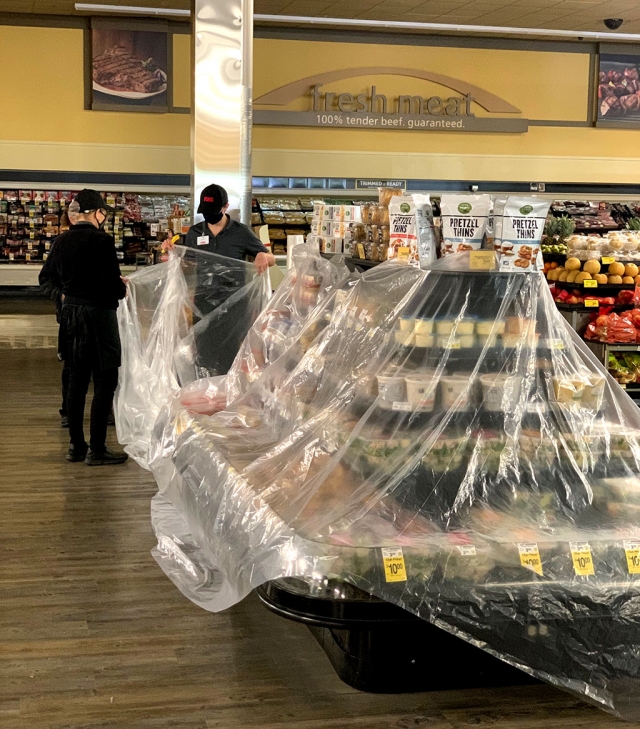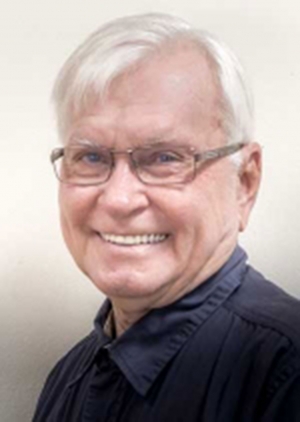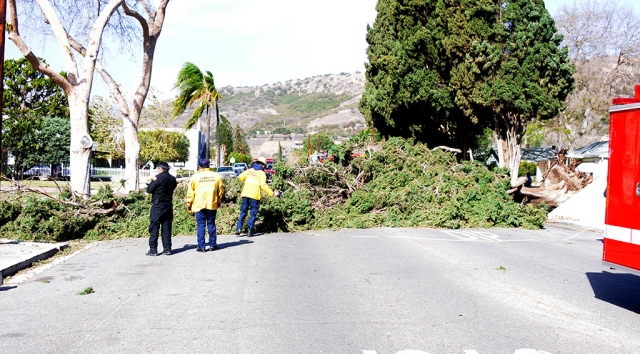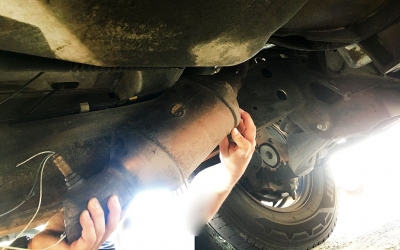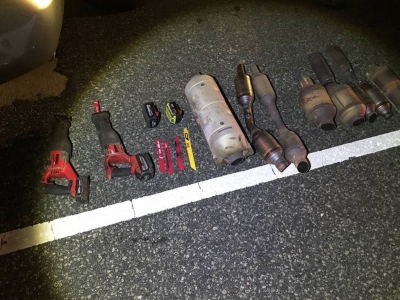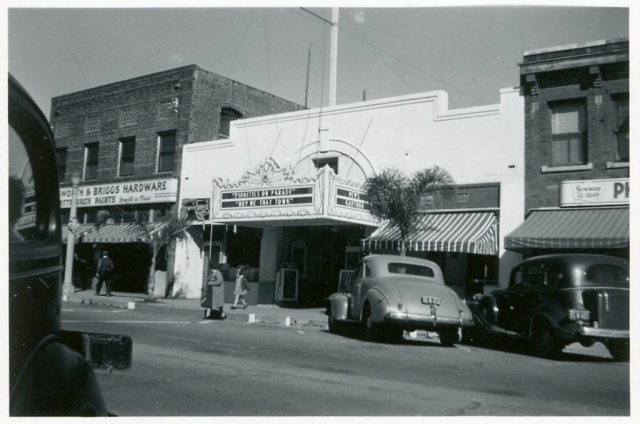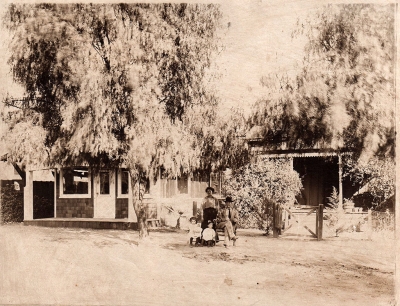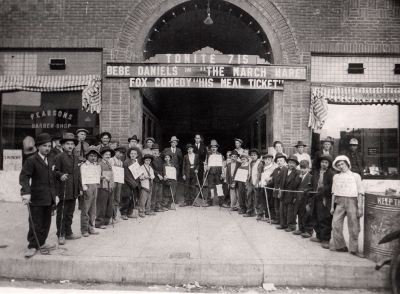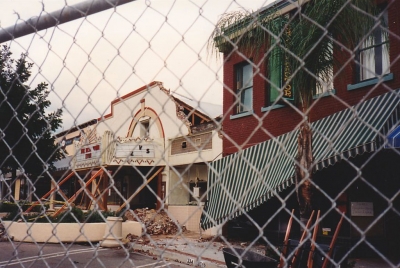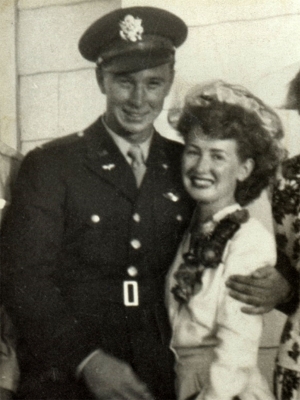|
By Anonymous — Wednesday, January 27th, 2021
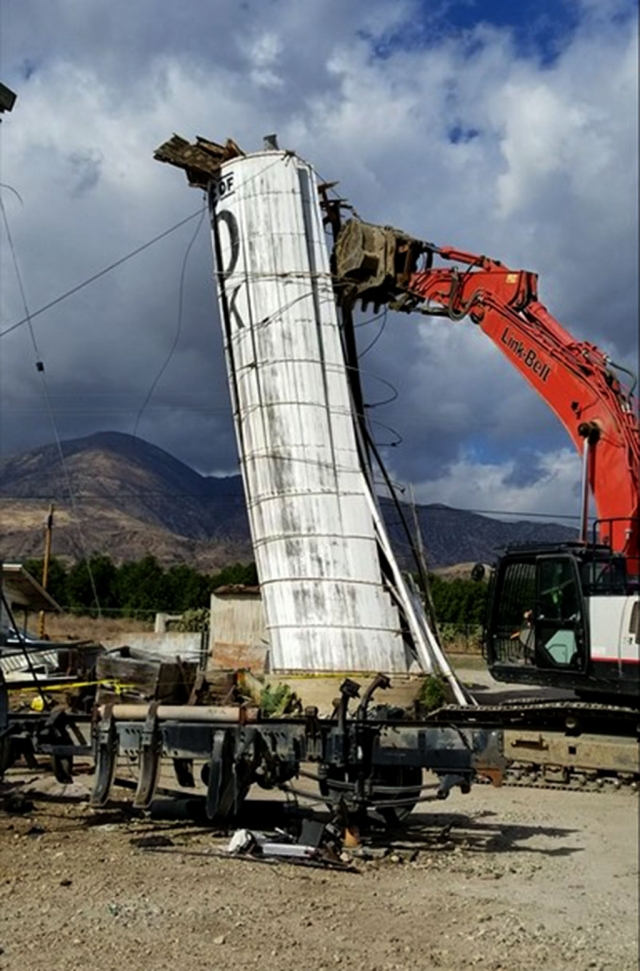 Last week the Santa Ana winds came through Fillmore in full force and caused damages to the historic landmark Sanitary Dairy silo that sits on Old Telegraph Road. (above) Crews taking down the silo after the winds passed. Enlarge Photo |
|
By Anonymous — Wednesday, January 27th, 2021
 An Edison cable in the Vons shopping center grid blew out Sunday afternoon, throwing the entire shopping strip and surrounding homes into darkness. Vons was closed for about 15 minutes, then re-opened using a generator. Enlarge Photo |
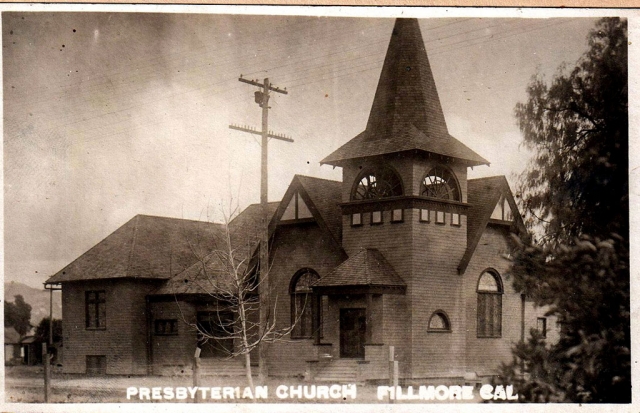 In October 1918, the first mention of the Spanish influenza appeared in a local newspaper. Pictured above is the Presbyterian Church circa 1910, which was converted into a temporary hospital in 1918 shortly after the announcement of the epidemic. Photos courtesy Fillmore Historical Museum. Enlarge Photo By Anonymous — Wednesday, January 27th, 2021
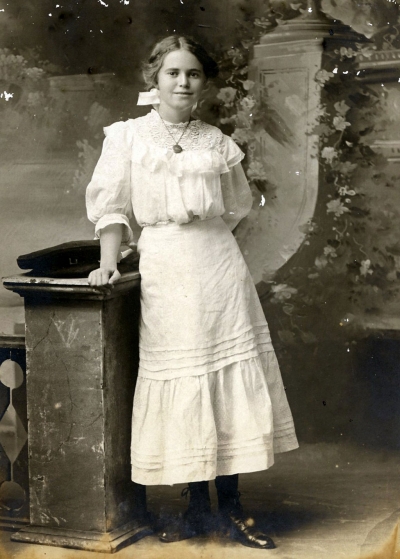 Vinnie Hinckley, daughter of Dr. J.P. Hinckley, who passed away at 15 years old due to the virus. Enlarge Photo Courtesy Fillmore Historical Museum The pandemic which swept the world from 1918 through at least 1920 did not skip over Fillmore. Inaccurately dubbed “Spanish” influenza, it was first identified at an Army camp in Kansas. The recruits shipped out to France and from there it spread. The “Spanish” appellation was derived from the fact that neutral Spain did not have the censorship controls that the Allied nations had and openly reported on the epidemic including the fact the Spanish king, Alfonso XIII, had contracted the disease. In the United States, it was believed that if the general public was aware of the situation it would hurt the war effort. The first mention of the epidemic appeared in the October 18, 1918, local paper. Because of the growing number of cases in the town, the school board debated closing the schools. After considerable discussion, it was decided to keep the schools open. Dr. W. R Manning, the city health officer, commented that there would be less danger of a serious epidemic if the children were kept in school than if the schools were closed and the youngsters allowed to run the streets. A week later, the tone in the paper was much different. The number of cases had exploded and there were deaths. Judge Merton Barnes, chairman of the Fillmore Red Cross, headed up the support effort aided by Mrs. Lawton and Mrs. Hadley as heads of the nursing team. At the suggestion of Hattie King, a temporary hospital was set up in the Presbyterian Church Sunday School at Sespe and Clay Streets. There the Red Cross volunteers aided the local Doctors Hinckley and Kerr as well as Dr. Soegaard from Piru and Dr. Mott from Santa Paula. Dr. Manning and his wife had contracted the virus so he was no longer able to attend to patients. Entire families were hit by the virus including the Harthorns, Fairbanks, Fosters, Froehlichs, Booths, and many others. A curfew was enacted, and public gatherings were banned. Pool halls and theaters were closed. A mountain lion hunt that had been scheduled was cancelled because the owners of the dogs were sick with influenza. By November 18, the epidemic seemed to have subsided, and the temporary hospital was closed. As a precaution schools remained closed. There was a sad report that the Reese family had lost 4 family members to influenza. Advice was given on the proper diet for victims. The situation continued to improve, and it was announced that the schools would reopen on November 25. It was decided that places of amusement should remain closed on Saturday evenings, when unusually large crowds congregate. The influenza of 1918, a strain of the H1N1-A virus, seemed to be particularly deadly to young adults, perhaps because it triggered a cytokine storm, which ravages the stronger immune system of young adults. This may explain why the next mention of the epidemic was on December 13, 1918 when a strict quarantine was announced. Dr. J. P. Hinckley, who lost his 15 year-old daughter, Vinnie, to the virus just a few weeks earlier, said he had twenty-five new cases, the majority of whom were high school students. Dr. Soegaard stated he had 19 patients, all high school students. It was decided that wherever the disease appeared a placard would be posted in a conspicuous place on the home, all cases had to be reported, and anyone residing in homes with the infections shall not be permitted to attend any public or private school or attend a public gathering. Churches were asked to cancel Christmas events and Mr. and Mrs. Richard Stephens cancelled their annual movie for the town’s children, although a toy giveaway would be held. |
|
By Anonymous — Wednesday, January 20th, 2021
|
|
By Anonymous — Wednesday, January 20th, 2021
 Tuesday afternoon, January 19th, Fillmore Fire and Police blocked off Central Avenue between 2nd and 3rd Street when the Santa Ana’s topple an 85-foot tree, blocking the road from curb to curb. The tree’s roots broke through the sidewalk in the 35-50 mph gusts. Fortunately, no injuries or damages other than the sidewalk were reported at the scene. Enlarge Photo |
|
By Anonymous — Wednesday, January 20th, 2021
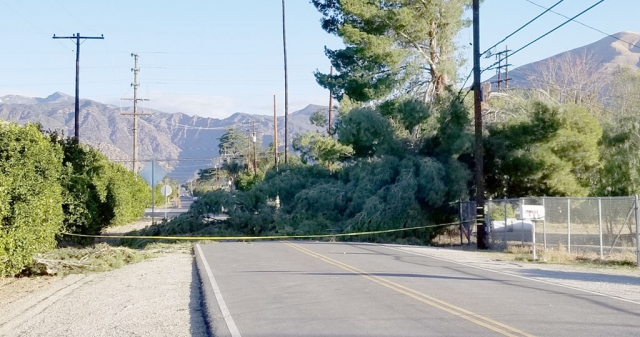 On Wednesday morning, January 20th Grand Avenue in the Fillmore was blocked off by a large tree taken down by the powerful Santa Ana winds. Enlarge Photo |
|
By Anonymous — Wednesday, January 20th, 2021
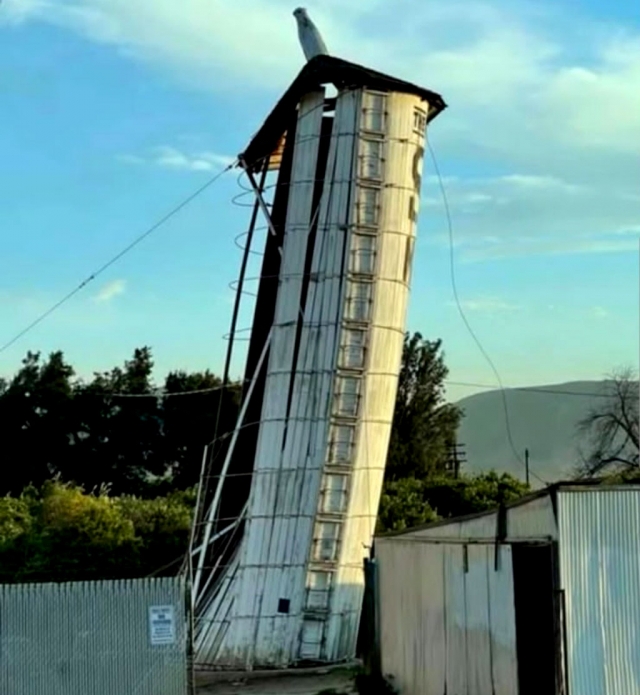 Gusty winds were not kind in Fillmore this past week. On Tuesday, January 19th the wind caused damages to the Sanitary Dairy which sits on Old Telegraph road in Fillmore is a historic national landmark in 1989 by the Ventura County Board of Supervisors. Enlarge Photo |
|
By Ventura County Sheriff Department — Wednesday, January 20th, 2021
Catalytic converter thefts are on the rise statewide. The Ventura County Sheriff’s Office is reminding the public to be aware and consider taking simple precautions that could help safeguard their vehicles from this and other types of crime. Your vehicle’s catalytic converter is a device used to reduce toxicity of emissions from an internal combustion engine. It is required by law on every motor vehicle operated in the United States since 1975. It is attached to your exhaust system underneath your car. Catalytic converters contain expensive precious metals like platinum, palladium and rhodium. These recyclable materials can be easily “scrapped” for a quick profit. Thieves usually commit these crimes in the early morning hours, often targeting trucks or SUVs because the higher ground clearance allows easier access underneath the vehicle. However, sports cars and sedans may also be targeted. The most common vehicles targeted are 1999-2003 Ford F/E series 250 and 350 vehicles, Toyota Prius, Honda Element, Honda Accord, and older model Jeep Cherokee SUV’s. WHAT CAN YOU DO TO PROTECT YOUR VEHICLE? Help us to deter this and other crimes. Be alert and aware while in parking lots, on roadways and in your neighborhood. Report suspicious activity by calling the Ventura County Sheriff's non-emergency number at 805-654-9511. If you see a crime in progress, call 9-1-1. Prepared by: Sergeant Victor Medina |
|
By Anonymous — Wednesday, January 20th, 2021
Courtesy Fillmore Historical Museum In January 1912, the citizens of Fillmore waited impatiently to find out who would win the contest to name the new moving picture theatre opening on Central Avenue. The winner would receive a coveted six month pass to theatre. The manager of the theatre, Merton Barnes, had been overwhelmed by entries. Some of them included “Fillmorine” (Elsie Sallee), “El Favorito” (E. A. Pyle), and “Citrus Valley Opera House” (Mrs. L. Snow). The winner was decided by a group of Fillmore luminaries, F. L. Fairbanks W. E. McCampbell, and John B. McNab. The winner entry was “The Empire” with Ralph Guerrant winning the pass. This theatre was in the Brinley Building, where 341/343 Central would be in 2021. The manager, Merton Barnes, had been in theatre stock companies traveling around the United States before coming to Fillmore and opening The Empire. Besides managing the theatre, in 1912 he was chosen as the Judge for Fillmore township and would serve as Judge for the City of Fillmore until 1928. He also coined the promotional slogan, “Fortune Favored Fillmore.” The Empire Theatre operated until 1916 presenting a mixture of movies, vaudeville acts, and speakers on a variety of subjects. In 1916, Leon Hammond built a commercial building where his home had previously stood. He was the son of a British surgeon and French mother and had arrived in Fillmore about 1905. His father served in the Confederate Army in the “War Between the States” and later emigrated to Brazil where Leon was born. They returned to the United States when Leon was a young child. The building Hammond built was to Merton Barnes’ specifications. According to his daughter, Barbara Barnes Jones, the stage was very modern with its equipment for scenery, a large door at the rear to bring scenery in and out and a trap door on stage. It had an orchestra pit which was later taken over by a large electric organ played by Mr. Sallee, Barbara Barnes or Pauline Irwin. There was also a steep pitch to the seating area about 5 feet, unusual for the time. There was a large lobby which had large picture frames in which photos of coming events were placed. Colors of cream and soft green were selected for the interior. As with the Empire, this was a multiuse facility. Besides motion pictures there were piano recitals, plays, public lectures and “Country Store” nights when groceries were given away at the movies. On November 2, 1917, there was a “RAH, RAH” night for high school students. According to the paper, students held a rally in front of the Barnes Theatre to boost the Fillmore-Ventura football game to be held the next day. Afterward they were guests of Judge Barnes at the Theatre. Mr. and Mrs. Richard Stephens hosted all the town’s children to a special Christmas movie, a tradition they had begun in 1912 at the Empire Theatre. In April 1920, to please the public, Judge Barnes ran a coupon in the paper asking people to send in their preferred time for weekday shows. Merton Barnes sold the theatre in October 1926, to H. C. Stearns and the name of the theatre was changed to the Stearns Theatre. In 1930, Mr. Stearns added the new marquee changing the look of the front of the theatre completely. If you look carefully today you can still see the top of the original arch behind the marquee. He also upgraded the sound equipment and added new lounge seats in the balcony. By 1931, the theatre changed hands again and became the “Fillmore Theatre”. The name was kept as the management of the theatre changed hands several times through the next decades. Connie Victoria told the Museum in a 2009 interview of the seating segregation in the theatre. She and her husband, Manuel (still in uniform from World War II), went to the theatre one night and asked to be seated in the loges. They were told there was no room so were seated on the main floor almost directly in front of the screen. Later in the evening, they looked up and saw the loges almost empty. When they confronted the assistant manager, he told them he was told not to seat Mexicans there. Connie escalated the issue to the county district attorney. Shortly thereafter, the theatre contacted them saying it was a misunderstanding and provided them free passes. From then on, they could sit wherever they wanted. By 1989, the building, by now the Towne Theatre and owned by Dale Larson, was deteriorating. The City Council allocated redevelopment funds to help in restoring the theatre, especially the marquee and lobby. Then in January 1994 the Northridge Earthquake struck, severely damaging the theatre and leaving it red tagged. As with many buildings in Fillmore, the Theatre was severely damaged in the January 1994 earthquake. After the 1994 Northridge earthquake the City of Fillmore purchased the building. Though extensive fund raising by citizens in the Save the Towne Theatre Committee, as grants the theatre was restored. It reopened in 1996 and showed first run movies. It did not, however, make enough to cover the upkeep of the building and the City made the decision to close it in 2011. Hopefully, the theatre that has survived over 100 years will someday again have a life as a theatre. |
|
By Anonymous — Wednesday, January 13th, 2021
George Richard Campbell of Fillmore passed peacefully on January 6, 2021 at 96 years of age from complications of COVID-19. Born in Cleveland, Oklahoma on October 21, 1924, his childhood was spent in several different places. His family finally moved to Superior, Arizona, where he graduated from high school. He and his family went through the Great Depression, which explains those frequent moves. Lois Lawanda Campbell, his loving wife of 75 years, also passed peacefully at the age of 96 at the family farm home on January 6, 2021, after a long bout of Alzheimer's disease. Born on July 17, 1924 in Superior, Arizona, she met George as a high school classmate in Superior. She was always known to all as Lawanda. George and Lawanda were inseparable in life and now in death. After graduation, George enlisted in the USAAF. He attended flight training and was commissioned as a lieutenant. During the latter part of WWII, he was one of the youngest first pilots of a B-17 and flew many bombing missions from bases in Italy and North Africa. During his flight training, he and Lawanda married in a small military ceremony. She accompanied him to training bases, and then returned to Superior after he was sent to Europe. Following the war, George returned to Arizona to rejoin Lawanda and their infant son, George Campbell, Jr. Shortly thereafter, the new family moved to Fillmore, where George began working as an auto mechanic for Rudkin Motors. Their second child, Carol Lynn Campbell, was born in 1946, followed four years later by David Roger Campbell, a former Mayor and City Councilman in Fillmore. Roger died at age 67 and is sorely missed by the entire family. George, Jr., and Carol deeply mourn their parents' passing. In Fillmore, George soon joined the Fillmore Fire Department as a volunteer, often being called out late at night and during holiday meals by the fire siren. He later served as Fire Chief for more than two decades. As all who knew George will attest, honesty, fairness, and public service were his watchwords. Lawanda staunchly supported George in everything he did, and was a smart, loving mother to her three children. She shared George's commitment to honesty and fairness and raised her children to maintain those standards. As their children became adults with their own families, she was a beloved grandmother, great-grandmother, and hostess for countless family gatherings. George opened Campbell's Auto Repair in the 1960s, first on Central Avenue and then on Santa Clara St. He was widely known as the best automotive diagnostician in the area. He was joined in the business by his son Roger. In the late 1960s, George and Lawanda purchased a 15-acre citrus orchard on Grand Avenue, a long-held dream for both of them. It was their home for the rest of their lives. The couple was always joined in a loving relationship. George and Lawanda are survived by their son George, Jr. and daughter-in-law Kathy Yakal, and their daughter Carol and son-in-law Patrick Askren. Four generations enjoyed family gatherings at their home on Grand Avenue. Their grandchildren, Patrick Askren, Jr., Chrissy (Askren) Fratzel, Mike Campbell, Laurie (Campbell) Best and their spouses make up the third generation. Eleven great-grandchildren, who all loved tractor rides and the orange groves at the Grand Avenue orchard, are the fourth generation now mourning the loss of George and Lawanda Campbell. Both George and Lawanda will rest in peace at Bardsdale Cemetery. Due to the COVID-19 pandemic, no services will be held at this time. |


